Christmas Cheer, 1932
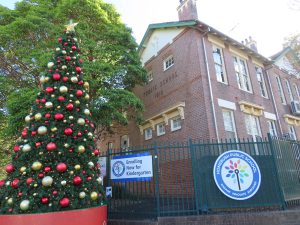
Homebush Public School, 21 December 2022. Courtesy Strathfield Local Studies
In December 1932 the Homebush Parents & Citizens’ Association and the Strathfield Community Service Club collected toys for Christmas for local children in need. The world was in the grip of the Great Depression and life was difficult for many families. The stock market crash of October 1929 had plunged the USA into an economic crisis that had quickly affected global trade. With no universal health or welfare payments, many Australians depended upon charities for assistance. Unemployment had already been high before the crash but by 1932 it had jumped to 32%. [1] The queues of unemployed were swelled that year after the opening of the Sydney Harbour Bridge left its construction workers also out of work.
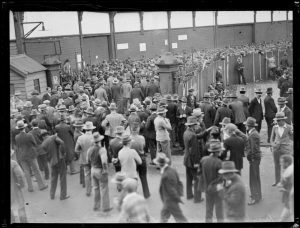
Crowd of unemployed men queuing for the dole during the Great Depression, New South Wales, c.1932. Courtesy National Library of Australia
By 1932 there were more than 60,000 men, women and children receiving the ‘susso,’ a sustenance payment that was barely adequate. [2]
Homebush Council’s minute books for 1932 note that a number of local men had written to council requesting work just to be able to pay their rates. Unfortunately Council could not afford to employ more men and indeed, had been forced to let some of its own employees go.
On 18 May Mayor Smallwood told Homebush Council: ‘We all feel sympathy for those people who are unemployed, and it is very necessary for the council to assist in every way possible.’ [3]
Government and Councils attempted to create employment schemes to assist the unemployed and their dependants. One such project to relieve unemployment began in July 1932 with the construction of stormwater channels and drains within the watershed of Powells Creek. This work included excavation, concreting and bricklaying. [4] Priority was to be given to local married men with children, often for a week at a time.
Newspapers also advertised each day for men from certain districts for specific projects. For example, on 25 August 1932 the Daily Telegraph advertised for men with experience as concrete labourers and horse-drivers, with four or five dependent children, who lived in municipalities including Enfield, Homebush and Strathfield.
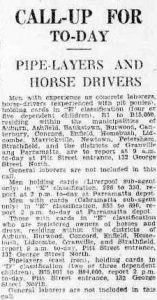
Daily Telegraph 25 August 1932 p.5 https://trove.nla.gov.au/newspaper/article/246304749
Ground improvements were also carried out at Homebush Public School in December 1932 under the Unemployed Relief Scheme. [5] Strathfield Council arranged for footpath construction work to be undertaken under the same scheme (Prevention and Relief of Unemployment Act 1930-31) in December 1932. [6]
Although these projects helped, the demand was still great. The Homebush Council minutes of 15 December 1932 note that, ‘Failing satisfactory negotiations with the Local Government Department to create relief for Christmas Week, it was resolved that a sum of £100 be voted for relief work for the local unemployed for Christmas Week, the work to be left in the hands of the Mayor and overseer.’ [7]
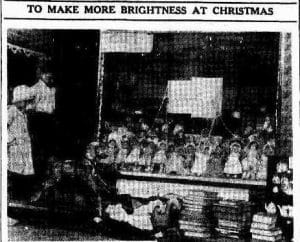
Toys collected during Homebush’s toy drive. Daily Telegraph 20 December 1932 p. 7
https://trove.nla.gov.au/newspaper/article/247316547
In the midst of this hardship, local residents rallied to remember the district’s children at Christmas. The Homebush Parents & Citizens’ Association, in conjunction with the Strathfield Community Service Club, organised a collection of toys. With the assistance of the 2nd Concord Boy Scouts, 300 parcels of toys were collected. ‘The distribution gladdened the hearts of more than 900 children in the Strathfield and adjoining districts. The success of the effort was due in a large measure to the co-operation of the teachers and children of the Homebush Public School.’ [8]
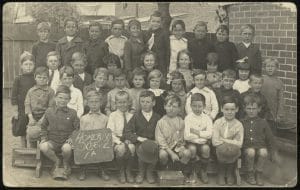
Class 1A Homebush Public School c.1920s-1930s. Courtesy NSW State Archives & Records.
This beautiful photo of Class 1A at Homebush Public School dates from the 1920s or 1930s. Although all the boys in the front row are wearing shoes, it is almost certain that those in the other rows are not. The few girls are heavily outnumbered. Perhaps some of these children’s families benefitted from the toy drive.
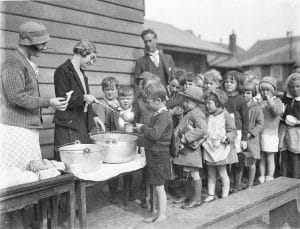
Belmore North Public School, 2 August 1934. Photo by Sam Hood. Courtesy State Library of NSW
Across Sydney, other schools also did what they could to alleviate distress. At Belmore North Public School the Parents & Citizens’ Association provided more than 300 bowls of soup and bread daily. They also provided warm clothing in winter. The boy at the front of the line receiving his soup wears no shoes even though it is winter time. It was quite common for boys to be shoeless, but considered less seemly for girls.
Although the worst of the Depression was over by the mid-1930s, it wasn’t until the outbreak of World War II in 1939 that the country really began to recover from economic hardship. But it is heartening to note that our community has a long history of rallying the forces to support those in need and spread a little Christmas cheer.
Merry Christmas to all!
By J.J. MacRitchie
Local Studies Advisor
References
[1] Murray, Lisa ‘Listening to the Great Depression’ Dictionary of Sydney https://home.dictionaryofsydney.org/listening-to-the-great-depression/[2] ‘Great Depression’ | National Museum of Australia https://www.nma.gov.au/defining-moments/resources/great-depression
[3] Homebush Council minutes 18 May 1932
[4] Government Gazette of the State of New South Wales 21 July 1932 p.2409 https://trove.nla.gov.au/newspaper/article/220263023
[5] Construction and Real Estate Journal 14 December 1932 p.12 https://trove.nla.gov.au/newspaper/article/222910327
[6] Government Gazette of the State of New South Wales 20 December 1932 p.4519 https://trove.nla.gov.au/newspaper/article/219912833/14092013
[7] Homebush Council minutes 15 December 1932
[8] Sydney Morning Herald 24 December 1932 p.13 https://trove.nla.gov.au/newspaper/article/16940724
